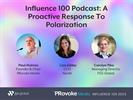Paul Holmes 13 Sep 2007 // 11:00PM GMT
by Marina Maher
Today I’m interviewing four candidates from your agencies. How many of my employees are you talking to? Last week you promoted someone to account supervisor and gave them a hefty increase. Today they resigned for a VP title elsewhere and a $20,000 raise.
In this Golden Age of PR we find ourselves facing “the perfect storm”: an unprecedented increase in business colliding with an ever-shrinking talent pool. The result is a staffing feeding frenzy, with agencies continually tapping the same resources, recruiting from each other and inflating salaries and titles.
Just how bad is this talent crisis? Think about how long your last key position on an account team remained open: eight months, a year? And you scramble to keep everything covered, yes? As a result, the workloads and stress levels of existing teams increases. Staffers get busier and busier until they realize their work/life balance is out of whack, so they burn out and transition to another industry, go to corporate or become part of a robust freelance network.
We can all do the math; there are more exits than entrances in our industry.
Stop the Recycling
I believe it’s time to stop the madness, throw out the old rules and completely rethink our approach to talent. To change the game, we need to step out of our industry and embrace non-traditional hires - candidates for agency positions who do not currently work in PR.
I’ve heard the objections: “They don’t know our business,” “Junior staff will resent them,” “Takes too much training,” “They can’t lead the clients from day one.”
Clearly, it takes time, training and patience to get non-traditional hires up to speed and assimilated into to our industry. I think it’s a wise investment and I’m not sure we have any choice.
Strategically populating your agency with non-traditional hires will help create a robust, diversified talent pool that will enhance your business with new competencies, expertise and perspectives. By virtue of their varied backgrounds, they will create a more interesting and multi-skilled workplace, bringing fresh thinking and a new set of lenses to view your clients’ challenges.
Where do these non-traditional hires come from? I’ve talked to a number of non-traditional hires and they come from diverse backgrounds: law, government, non-profits, marketing, sales, branding and advertising agencies.
Start the Transition
A number of firms have already embraced the notion of non-traditional hires and The Council of Public Relations Firms is spearheading several programs to assist both agencies and employees. As a board member, I am managing the Council’s research and education-driven initiative to help non-traditional hires transition successfully into PR. Currently in the research phase, we are conducting focus groups with PR professionals who came from non-traditional backgrounds (but who have worked in agencies for at least a year), to give us the low-down on the challenges of a mid- or late-career switch to PR. We are also working with Deloitte Touche on the creation of a national survey to get the perspectives of non-traditional hires.
This research will build the program’s next phase: giving our new colleagues the tools they need to succeed in our business. The Council is updating the current version of the PR QuickStart software package, a type of “PR 101” primer that will become a bible for non-traditional hires. In the future, as more non-traditional hires join the industry, we will explore a partnership with a PR academic center, such as Syracuse University’s S.I. Newhouse School of Public Communications, on an advanced online training course.
We’ve already received some meaningful insights from our focus groups. When asked which transferable skills are most important for succeeding in PR agencies, they cited the ability to: think on your feet and deal with ambiguity, operate in ‘gray areas’ where relationship building is key, work outside your comfort zone and manage your own career. They also talked about having to deal with getting hired at a level lower than they believed their skills were and expressed concerns about how quickly they might get promoted. To this list, we might also add that non-traditional hires need: a service mentality, the ability to connect and integrate, problem solving skills and a basic willingness to learn and be coachable. As importantly, I believe all hires, and especially non-traditionals, need an intellectual curiosity. They need to ask questions about everything. They also need to be voracious readers and consumers of information relevant to the accounts they manage.
Expanding Our Thinking
In some cases, attributes differ from those we seek in traditional hires. In the past, agency hires had to be Jacks (and Janes) of all trades. If mid- and senior-level candidates weren’t proficient in creativity AND strategy AND account management AND writing AND media relations AND finances AND programming (whew!), there was no room at the inn. Today, hiring outside the box means re-examining and updating not only hiring and required skill sets, but also orientation practices.
Setting up non-traditional mid- and senior-level managers for success requires a commitment from senior management and Human Resources. And a plan. We recommend five steps, based on our own experience with non-traditional hires, to provide sure footing as we cover new ground:
• No Surprises. To manage expectations, announce non-traditional hires internally and to clients - carefully positioning their prior experience and expertise. This way, clients and colleagues will appreciate the value they bring to the business. It will also buy them some “amnesty time.”
• This isn’t “Survivor.” Expecting these hires to sink or swim on their own is unfair to them and their teams. Assign a coach or mentor to help ease their transition to PR, and help ensure that no one will vote them off the island.
• Like a fine wine, they need time. Along with a mentor, give non-traditional hires time for a learning curve. Assuming they’ll be up to speed on all things PR in a week (or three) is counterproductive and brings added stress to all involved.
• The resume is half full. Don’t let yourself -or your people- focus on skills or experience your non-traditional hire may be lacking. Concentrate on the positives your new find brings to the table, such as areas of expertise your team needs. You may find yourself with novel solutions to old problems.
• Get on the train. An education action plan to help flatten the learning curve is a must. As we learned from our focus groups, non-traditional hires want and need training, especially in areas such as writing decks and presenting. Determine how and in what areas you will provide this training, insert metrics to measure progress and provide ongoing, constructive feedback.
The bottom line? Attracting and retaining non-traditional hires takes time, effort and resources, but the potential rewards are great. Just imagine – your accounts will be staffed more quickly; your agency will be re-energized with fresh insights and perspectives; and maybe your hair will grey more slowly. And, by leveraging non-traditional hires’ diverse backgrounds, you can offer existing and prospective clients a wider scope of expertise and service.
So, what are we waiting for? Let’s stop circling the pool and start fishing from the ocean.


































.jpg)

















